
Lycopodium clavatum is the most widespread species in the genus Lycopodium in the clubmoss family.

Allium canadense, the Canada onion, Canadian garlic, wild garlic, meadow garlic and wild onion is a perennial plant native to eastern North America from Texas to Florida to New Brunswick to Montana. The species is also cultivated in other regions as an ornamental and as a garden culinary herb. The plant is also reportedly naturalized in Cuba.
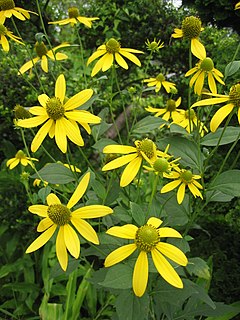
Rudbeckia laciniata, commonly called cutleaf coneflower, is a species of flowering plant in the aster family (Asteraceae). It is native to North America, where it is widespread in both Canada and the United States. Its natural habitat is wet sites in flood plains, along stream banks, and in moist forests.
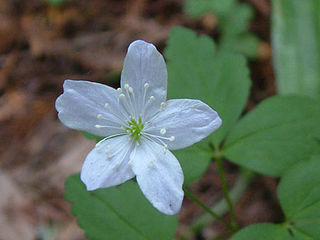
Anemonoides quinquefolia, a flowering plant in the buttercup family Ranunculaceae, is native to North America. It is commonly called wood anemone or windflower, not to be confused with Anemonoides nemorosa, a closely related European species also known by these common names. The specific epithet quinquefolia means "five-leaved", which is a misnomer since each leaf has just three leaflets. A plant typically has a single, small white flower with 5 sepals.

Viola canadensis is more commonly known as Canadian white violet, Canada violet, tall white violet, or white violet. It is widespread across much of Canada and the United States, from Alaska to Newfoundland, south as far as Georgia and Arizona.

Viola sororia, known commonly as the common blue violet, is a short-stemmed herbaceous perennial plant that is native to eastern North America. It is known by a number of common names, including common meadow violet, purple violet, woolly blue violet, hooded violet, and wood violet. Its cultivar 'Albiflora' has gained the Royal Horticultural Society's Award of Garden Merit.

Trillium ovatum, the Pacific trillium, also known as the western wakerobin, western white trillium, or western trillium, is a species of flowering plant in the family Melanthiaceae. It is found in western North America, from southern British Columbia and the tip of southwestern Alberta to central California, east to Idaho and western Montana. There is an isolated population in northern Colorado and southern Wyoming.
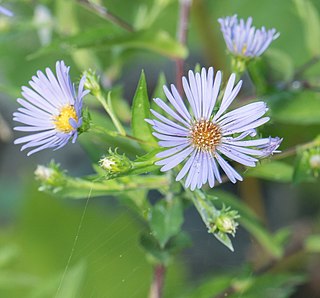
Symphyotrichum puniceum, commonly known as purplestem aster, red-stalk aster, red-stemmed aster, red-stem aster, or swamp aster, is a perennial herb native to eastern North America. It has also been called early purple aster and meadow scabish.

Symphyotrichum ericoides, known as white heath aster, frost aster, or heath aster, is a species of flowering plant in the daisy family Asteraceae, native to much of central and eastern North America. It has also been introduced to parts of Europe and western Asia.

Balsamorhiza is a genus of plants in the sunflower family known commonly as balsamroots. These are perennials with fleshy taproots and caudices bearing erect stems and large, basal leaves. Atop the tall stems are showy yellow sunflower-like blooms. Balsamroots are native to western North America.
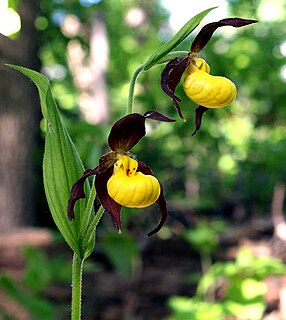
Cypripedium parviflorum, commonly known as yellow lady's slipper or moccasin flower, is a lady's slipper orchid native to North America. It is widespread, ranging from Alaska south to Arizona and Georgia.

Symphyotrichum pilosum, commonly called the hairy white oldfield aster or frost aster, is an herbaceous plant in the aster family.

Ribes americanum is a North American species of flowering plant in the gooseberry family known as wild black currant, American black currant, and eastern black currant. It is widespread in much of Canada and the northern United States.

Liatris squarrosa, commonly called the scaly blazingstar, is an herbaceous perennial plant native to eastern and central North America, with most populations in the Southeastern United States. It is a somewhat conservative species, often found in dry or rocky areas of native prairie and savanna vegetation. It produces purple flowerheads in the summer.

Symphyotrichum dumosum is a species of flowering plant in the aster family. It is native to a widespread area across the eastern half of the United States from Texas to Florida to Maine to Wisconsin. It is also native to Ontario, introduced in New Brunswick, and cultivated in other places. It is commonly known as rice button aster and bushy aster.

Corallorhiza odontorhiza, common name fall coral-root or small-flowered coral-root, is a species of orchid widespread across eastern and central United States, and reported also from Mexico, Central America, Quebec and Ontario. In North America, it occurs in forested areas up to an elevation of 2800 m.
Rubus setosus, the bristly blackberry, is a North American species of flowering plant in the rose family. It is widespread in much of central and eastern Canada and the northeastern and north-central United States

Fimbristylis puberula, commonly called hairy fimbry, is a species of flowering plant in the sedge family (Cyperaceae). It is native to North America, where it has a widespread, but patchy, distribution. The largest populations are in the Southeastern Coastal Plain and the eastern Great Plains. Its natural habitat is in prairies, savannas, and glades. It can be found on both basic and acidic soil.
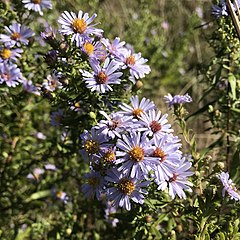
Symphyotrichum praealtum, known as willowleaf aster and willow aster is a species of flowering plant in the aster family, Asteraceae. It is native to North America and introduced in Europe.

Petrorhagia saxifraga, known as tunic flower or coat flower, is a small, herbaceous flowering plant in the family Caryophyllaceae. It is native to parts of Europe and introduced to the United States and Canada, Great Britain, and Sweden. Petrorhagia saxifraga is also known as tunic saxifrage, pink saxifrage, or just pink.



















